Important Questions
SHORT ANSWER TYPE QUESTIONS [II] [3 Marks] – Year 2007
1. A concave lens has focal length of 20 cm. At what distance from the lens a 5 cm tall object be placed so that it forms an image at 15 cm from the lens? Also calculate the size of the image formed. [Delhi]
Answer.
2. An object 50 cm tall is placed on the principal axis of a convex lens. Its 20 cm tall image is formed on the screen placed at a distance of 10 cm from the lens. Calculate the focal length of the lens. [All India]
Answer.
CBSE Class 10 Science – More Resources
| NCERT Solutions for Class 10 Science | NCERT Exemplar Class 10 Science |
| CBSE Class 10 Previous Year Question Papers | Class 10 Science Important Questions |
LONG ANSWER TYPE QUESTION [5 Marks] – Year 2007
3. Draw the ray diagram in each case to show the position and nature of the image formed when the object is placed:
(i) at the centre of curvature of a concave mirror
(ii) between the pole P and focus F of a concave mirror
(iii) in front of a convex mirror
(iv) at 2F of a convex lens
(v) in front of a concave lens
Answer.
Nature of image: Real, inverted and same size image is formed at the centre of curvature.
Nature of image: Virtual, enlarged and erect image is formed behind the mirror.
Nature of image: Virtual, erect and diminished, image is formed behind the mirror.
Nature of image: Real, inverted and size to size, image is formed at 2F on the other side of lens.
Nature of image: Virtual, erect and diminished image is formed between O and F on the same side of object.
VERY SHORT ANSWER TYPE QUESTIONS [1 Mark] – Year 2008
4. If a light ray IM is incident on the surface AB as shown, identify the correct emergent ray. [Delhi (C)]
Answer. Ray NQ, as it has to be parallel to ray OS.
5. The refractive indices of four media A, B, C and D are given in the following table:
If light, travels from one medium to another, in which case the change in speed will be (i) minimum, (ii) maximum? [Delhi(C)]
Answer. (i) Minimum change is seen as light moves between 1.50 and 1.52, i.e. B and C.
(ii) Maximum change when light moves between 1.33 and 2.40, i.e. A and D.
6. “The refractive index of diamond is 2.42”. What is the meaning of this statement in relation to speed of light? [Delhi]
Answer.
7. Redraw the given diagram and show the path of the refracted ray: [All India(C)]
Answer.
8. Redraw the given diagram and show the path of the refracted ray: [All India(C)]
Answer.
9. Draw the following diagram in your answer book and show the formation of image of the object AB with the help of suitable rays. [All India]
Answer.
10. Which kind of mirrors are used in the headlights of a motor-car and why? [Foreign]
Answer. Concave mirror, to get the parallel beam of light.
SHORT ANSWER TYPE QUESTIONS [I] [2 Marks] – Year 2008
11. Explain with the help of a diagram, why a pencil partly immersed in water appears to be bent at the water surface. [Delhi]
Answer. Light from different points on the pencil, immersed in water refracts and appears to come from a point above the original position.
12. Draw ray diagrams to represent the nature, position and relative size of the image formed by a convex lens for the object placed:
(a) at 2F1
(b) between F1 and the optical centre O of lens: [All India]
Answer.
13. A ray of light, incident obliquely on a face of a rectangular glass slab placed in air, emerges from the opposite face parallel to the incident ray. State two factors on which the lateral displacement of the emergent ray depends. [Foreign]
Answer. Lateral displacement depends on the:
- angle of incidence,
- thickness of slab, and
- refractive index of the material. (any two)
SHORT ANSWER TYPE QUESTIONS [II] [3 Marks] – Year 2008
14. An object 2 cm in size is placed 30 cm in front of a concave mirror of focal length 15 cm. At what distance from the mirror should a screen be placed in order to obtain a sharp image? What will be the nature and the size of the image formed? Draw a ray diagram to show the formation of the image in this case. [Delhi(C)]
Answer.
15. An object 2 cm high is placed at a distance of 64 cm from a white screen. On placing a convex lens at a distance of 32 cm from the object it is found that a distinct image of the object is formed on the screen. What is the focal length of the convex lens and size of the image formed on the screen? Draw a ray diagram to show the formation of the image in this position of the object with respect to the lens. [Delhi(C)]
Answer. Since, object-screen distance is double of object-lens separation, the object is at a distance of 2f from the lens and the image should be of the same size of the object.
16. A convex lens has a focal length of 10 cm. At what distance from the lens should the object be placed so that it forms a real and inverted image 20 cm away from the lens? What would be the size of the image formed if the object is 2 cm high? With the help of a ray diagram show the formation of the image by the lens in this case. [All India (C)]
Answer.
LONG ANSWER TYPE QUESTION [5 Marks] – Year 2008
17. (a) It is desired to obtain an erect image of an object, using a concave mirror of focal length 20 cm.
(i) What should be the range of distance of the object from the mirror?
(ii) Will the image be bigger or smaller than the object?
(iii) Draw a ray diagram to show the image formation in this case.
(b) One half a convex lens of focal length 20 cm is covered with a black paper.
(i)Will the lens produce a complete image of the object?
(ii)Show the formation of image of an object placed at 2F1 of such covered lens with the help of a ray diagram.
(iii)How will the intensity of the image formed by half-covered lens compare with non-covered lens? ‘ [Foreign]
Answer.
VERY SHORT ANSWER TYPE QUESTIONS [1 Mark] – Year 2009
18. Redraw the diagram given below in your answer book and show the direction of the light ray after reflection from the mirror. [Delhi (C)]
Answer.
19. Redraw the diagram given below in your answer book and show the direction of the light ray after reflection from the mirror. [Delhi (C)]
Answer.
20. Redraw the diagram given below in your answer book and show the direction of the light ray after reflection from the mirror. [Delhi (C)]
Answer.
21. Redraw the diagram given below in your answer book and show the direction of the light ray after refraction from the lens. [Delhi, All India(C)]
Answer.
22. Why does a ray of light bend when it travels from one medium into another? [Delhi]
Answer. Due to change in velocity in the medium and to reduce the time taken to travel the same.
23. Redraw the diagram given below in your answer book and show the direction of the light ray after refraction from the lens. [All India (C)]
Answer.
SHORT ANSWER TYPE QUESTIONS [I] [2 Marks] – Year 2009
24. What is the minimum number of rays required for locating the image formed by a concave mirror for an object. Draw a ray diagram to show the formation of a virtual image by a concave mirror. [Delhi]
Answer.
25. The refractive index of water is 1.33 and the speed of light in air is 3 x 108 ms-1. Calculate the speed of light in water. [Foreign]
Answer.
26. The refractive index of glass is 1.50 and the speed of light in air is 3 x 108 ms-1. Calculate the speed of light in glass. [Foreign]
Answer.
SHORT ANSWER TYPE QUESTIONS [II] [3 Marks] – Year 2009
27. For which position of the object does a convex lens form a virtual and erect image? Explain with the help of a ray diagram. [All India]
Answer. When the object is placed between the focus and the optical centre, a virtual and erect image is formed.
VERY SHORT ANSWER TYPE QUESTIONS [1 Mark] – Year 2010
28. Explain why a ray of light passing through the centre of curvature of a concave mirror, gets reflected along the same path. [Delhi]
Answer. The ray passing through the centre of curvature incident to the mirror along its normal so ∠i= ∠r = 0. Therefore, the ray retraces its path.
29. What is the nature of the image formed by a concave mirror if the magnification produced by the mirror is +3? [Delhi]
Answer. Positive sign of magnification indicates that image is virtual, erect and enlarged.
30. Between which two points of a concave mirror should an object be placed to obtain a magnification of -3? [Delhi]
Answer. Negative sign of magnification indicates that image is real and inverted. Also size of image is enlarged. So, object must be positioned between F and 2F, i.e. C.
31. “The refractive index of carbon disulphide is 1.63.” What is the meaning of this statement in relation to speed of light? [Delhi]
Answer. Speed of light in carbon disulphide is 1/1.63 times the speed of light in free space.
32. The outer surface of a hollow sphere of aluminium of radius 50 cm is to be used as a mirror. What will be the focal length of this mirror? Which type of spherical mirror will it provide? [Delhi]
Answer. f = R/2 = 25 cm. It will form a convex mirror.
33. Between which two points related to a concave mirror should an object be placed to obtain on a screen an image twice the size of the object? [All India]
Answer. Real Image: Between F and C.
34. How should a ray of light be incident on a rectangular glass slab so that it comes out from the opposite side of the slab without being displaced? [Foreign]
Answer. Along the normal to the surface or at an incident angle of i = 0°.
35. A girl was playing with a thin beam of light from her laser torch by directing it from different directions on a convex lens held vertically. She was surprised to see that in a particular direction the beam of light continues to move along the same direction after passing through the lens. State the reason for this observation. [Foreign]
Answer. A ray of light passing through the optical centre of the convex lens will continue to move along the same direction after refracting through the lens.
36. A ray of light enters a rectangular glass slab of refractive index 1.5. It is found that the ray emerges from the opposite face of the slab without being displaced. If its speed in air is 3 x 108 ms-1 then what is its speed in glass? [Foreign]
Answer.
37. The speed of light in a transparent medium is 0.6 times that of its speed in vacuum. What is the refractive index of the medium? [Foreign]
Answer.
SHORT ANSWER TYPE QUESTION [I] [2 Marks] – Year 2010
38. In an experiment with a rectangular glass slab, a student observed that a ray of light incident at an angle of 55° with the normal on one face of the slab, after refraction strikes the opposite face of the slab before emerging out into air making an angle of 40° with the normal. Draw a labelled diagram to show the path of this ray. What value would you assign to the angle of refraction and angle of emergence? [All India]
Answer.

SHORT ANSWER TYPE QUESTION [II] [3 Marks] – Year 2010
39. At what distance should an object be placed from a convex lens of focal length 18 cm to obtain an image at 24 cm from it on the other side. What will be the magnification produced in this case? [Delhi]
Answer.
40. How far should an object be placed from a .convex lens of focal length 20 cm to obtain its image at a distance of 30 cm from the lens? What will be the height of the image if the object is 6 cm tall? [All India]
Answer.

41. The image of an object placed at 60 cm in front of a lens is obtained on a screen at a distance of 120 cm from it. Find the focal length of the lens. What would be the height of the image if the object is 5 cm high? [Foreign]
Answer.


SHORT ANSWER TYPE QUESTION [I] [2 Marks] – Year 2011
42. State the two laws of reflection of light. [Delhi]
Answer. Laws of reflection of light are:
- The angle of incidence is equal to the angle of reflection.
- The incident ray, the normal to the reflecting surface at the point of incidence and reflected ray from that point, all lies in the same plane.
43. Define and show on a diagram, the following terms relating to a concave mirror:
(i) Aperture
(ii) Radius of curvature [Foreign]
Answer. (i) The diameter of the reflecting surface of the mirror is called aperture.
(ii) The radius of the sphere of which the reflecting surface of the spherical mirror forms a part is called the radius of curvature of the mirror.
44. Define the focus of a concave mirror. If the radius of curvature of a convex mirror is 30 cm, what would be its focal length? [Foreign]
Answer. The point on the principal axis where all the rays parallel to it meet after reflection is called focus. Since, R = 30 cm and f=R/2 we have, f=+15 cm for a convex mirror.
45. Distinguish between a real and a virtual image of an object. What type of image is formed (i) by a plane mirror, (ii) on a cinema screen? [Foreign]
Answer. If light rays after reflection converge to a point to form an image on its own, it is called a real image. If they are diverging, then they form a virtual image. Real image can be obtained on a screen, while a virtual image cannot be.
(i) Plane mirror forms virtual image.
(ii) On cinema screen, real image is formed.
SHORT ANSWER TYPE QUEST10NS [II] [3 Marks] – Year 2011
46. Draw a ray diagram and also state the position, the relative size and the nature of image formed by a concave mirror when the object is placed at the centre of curvature of the mirror. [Delhi]
Answer.
47. Define ‘refractive index of a transparent medium.’ What is its unit? Which has a higher refractive index, glass or water? [Delhi]
Answer. The ratio of the speed of light in the free space (c) to the speed of light in given medium (ѵ) is called its refractive index.
n=c/ѵ
It has no unit. Glass has more refractive index than water.
48. A ray of light travelling in air enters obliquely into water. Does the light ray bend towards or away from the normal ? Why? Draw a ray diagram to show the refraction of light in this situation. [Delhi]
Answer. Light bends towards the normal because water is denser than air.
The ray bends towards the normal because it has to travel with a lesser speed in water but with shorter time.
49. (a) “The refractive index of diamond is 2.42”. What is the meaning of this statement?
(b) Name a liquid whose mass density is less than that of water but it is optically denser than water. [Delhi]
Answer. (a) This means that the ratio of speed of light in air and the speed of light in diamond is equal to 2.42. (b) Kerosene
50. An object is placed between infinity and the pole of a convex mirror. Draw a ray diagram and also state the position, the relative size and the nature of the image formed. [All India]
Answer.
51. What is the principle of reversibility of light? Show that the incident ray of light is parallel to the emergent ray of light when light falls obliquely on a side of a rectangular glass slab. [All India]
Answer. The final path of the ray of light after reflections or refractions is reversed; the ray retraces its entire path. This principle is called reversibility of light.

Hence incident ray PQ is parallel to the emergent ray RS when light falls obliquely on a side of rectangular glass slab.
52. With the help of a ray diagram explain why a convex mirror is preferred for rear view mirrors in motor cars. [Foreign]
Answer. (i) It always forms a virtual, erect and diminished image.
(ii) The field of view increases while using a convex mirror as shown.
53. What is understood by lateral displacement of light? Illustrate it with the help of a diagram. List any two factors on which the lateral displacement of a particular substance depends. [Foreign]
Answer. Lateral displacement is the perpendicular distance between the incident ray produced and the emergent ray. Lateral displacement in the diagram is BL. The lateral displacement depends on the thickness of the slab, the incident and refraction angles.
54. Draw the ray diagram and also state the position, relative size and nature of the image formed by a concave mirror when the object is placed between its centre of curvature, C and focus, F. [Foreign]
Answer.
LONG ANSWER TYPE QUESTIONS [5 Marks] – Year 2011
55. (a) If the image formed by a lens is diminished in size and erect, for all positions of the object, what type of lens is it?
(b) Name the point on the lens through which a ray of light passes undeviated.
(c) An object is placed perpendicular to the principal axis of a convex lens of focal length 20 cm. The distance of the object from the lens is 30 cm. Find (i) the position (ii) the magnification and (iii) the nature of the image formed. [Delhi]
Answer. (a) Concave lens.
(b) Optical centre.
(c) u = – 30 cm, f = 20 cm
(iii) Image is real as v > 0, inverted and enlarged.
56. (a) What is meant by ‘power of a lens’?
(b) State and define the S.I. unit of power of a lens.
(c) A convex lens of focal length 25 cm and a concave lens of focal length 10 cm are placed in close contact with each other. Calculate the lens power of this combination. [All India]
Answer.
57. (а) Draw a ray diagram to show the formation of image of an object placed between infinity and the optical centre of a concave lens.
(b) A concave lens of focal length 15 cm forms an image 10 cm from the lens. Calculate
(i) the distance of the object from the lens.
(ii) the magnification for the image formed.
(iii) the nature of the image formed. [All India]
Answer. (a) Image formation when the object is at any position between infinity and optical centre:
58. (a) Under what condition will a glass lens placed in a transparent liquid become invisible?
(b) Describe and illustrate with a diagram, how we should arrange two converging lenses so that a parallel beam of light entering one lens emerges as a parallel beam after passing through the second lens.
(c) An object is placed at a distance of 3 cm from a concave lens of focal length 12 cm. Find the (i) position and (ii) nature of the image formed. [Foreign]
Answer. (a) When the refractive index of glass lens becomes equal to the refractive index of transparent liquid, the glass lens will become invisible.
(b) Parallel beam converges at focus of the first lens and emerges parallel as it is at the focus of second lens.
59. (a) With the help of a ray diagram explain why a concave lens diverges the rays of a parallel beam of light.
(b) A 2.0 cm tall object is placed perpendicular to the principal axis of a concave lens of focal length 15 cm. At what distance from the lens, should the object be placed so that it forms an image 10 cm from the lens? Also find the nature and the size of image formed. [Foreign]
Answer. (a) When a parallel beam of light incident on a front face of concave lens, each ray of light will refract towards the normal to the surface as it moves from rarer to denser medium and travels in a straight line inside the lens until it reaches the ‘ back face of the lens. At the back face boundary, each ray of light will again refract and bend away from the normal to the surface as it moves from denser to rarer medium. The course of ray of light is shown in the following figure.
Thus, because of the concave shape of both the faces, the double concave lens diverge the rays of parallel beam of incident light.
SHORT ANSWER TYPE QUESTION [I] [2 Marks] – Year 2012
60. List four properties of the image formed by a plane mirror. [Delhi]
Answer. Properties of image formed by a plane mirror:
- It is always virtual and erect.
- Its size is equal to that of the object.
- It is formed at the same distance behind the mirror as the object is in front of the mirror.
- It is laterally inverted.
61. List four properties of the image formed by a convex mirror. [Delhi]
Answer. Properties of image formed by a convex mirror:
- It is always formed behind the mirror, between the pole and its focus.
- It is always virtual and erect.
- Its size is always smaller than the object.
- Magnification is always positive.
62. List four properties of the image formed by a concave mirror, when object is placed between focus and pole of the mirror. [Delhi]
Answer.
- The image is formed behind the mirror.
- It is enlarged, he. magnified.
- It is virtual.
- It is erect.
63. To instruct a ray diagram, we use two light rays which are so chosen that it is easy to know their directions after refraction from the lens. List these two rays and state the path of these rays after refraction. Use these two rays to locate the image of an object placed between ‘F and ‘2F of a convex lens. [Foreign]
Answer. Two rays choose for refraction:
(i) A ray of light parallel to the principal axis.
(ii) A ray of light passing through the optical centre of a lens.
Path of these rays after refraction:
In case of convex lens, the first ray will pass through the principal focus on the other side of the lens.
In case of concave lens, the first ray will
(a) appear to diverge or
(b) appear to come from the principal focus positioned on the same side of the object.
The second ray emerge from the lens without any deviation in the path.
SHORT ANSWER TYPE QUESTION [II] [3 Marks] – Year 2012
64. State the type of mirror preferred as (i) rear view mirror in vehicles, (i0 shaving mirror. Justify your answer giving two reasons in each case.[Delhi] ?
Answer. (i) Convex mirror (ii) Concave mirror
Justification:
(i) Convex mirror is used as a rear view mirror because:
(a) it gives a wider field of view as it is curved outwards and
(b) it produces erect and diminished image of the traffic behind the driver of the vehicle.
(ii) Concave mirror is used as a shaving mirror to see a large size image of the face. When the object lies in between pole and principal focus of a concave mirror, it forms a virtual, erect and enlarged image behind it.
65. The image of a candle flame placed at a distance of 45 cm from a spherical lens is formed on a screen placed at a distance of 90 cm from the lens.
Identify the type of lens and calculate its focal length. If the height of the flame is 2 cm, find the height of its image. [Delhi]
Answer.
So, height of image is 4 cm. Negative sign indicates that it is formed below the principal axis.
66. A 4 cm tall object is placed perpendicular to the principal axis of a convex lens of focal length 24 cm. The distance of the object from the lens is 16 cm. Find the position, size and nature of the image formed, using the lens formula. [All India]
Answer.
Position of image: Image is formed at a distance of 48 cm from the optical centre of the lens on the same side of the object. It is indicated by the negative sign.
Size of image: It is three times the size of object, i.e. 12 cm.
Nature of image: Positive sign in the image height indicates that image is virtual and erect.
67. Name the type of mirror used in the following situations:
(i) Headlights of a car (ii) Rear-view mirror of vehicles (iii) Solar furnace Support your answer with reason. [All India][Foreign]
Answer. Type of mirror used in
(i) Headlights of a car: Concave mirror Concave mirror is used because light from the bulb placed at the focus of it gets reflected and produces a powerful parallel beam of light to illuminate the road.
(ii) Rear view mirror of vehicles: Convex mirror
Convex mirror is used because it always produces a virtual, and erect image whose size is smaller than the object. Therefore it enables the driver to see wide field view of the traffic behind the vehicle in a small mirror.
(iii) Solar furnace: Concave mirror
Concave mirror has the property to concentrate the sunlight coming from sun along with heat radiation at its focus. As a result, temperature at its focus increases and the substance placed at the focal point gets heated to a high temperature.
68. A 6 cm tall object is placed perpendicular to the principal axis of a convex lens of focal length 15 cm. The distance of the object from the lens is 10 cm. Find the position, size and nature of the image formed, using the lens formula. [Foreign]
Answer. For convex lens
f = +15 cm, u = – 10 cm
LONG ANSWER TYPE QUESTIONS [5 Marks] – Year 2012
69. List the sign conventions for reflection of light by spherical mirrors. Draw a diagram and apply these conventions in the determination of focal length of a spherical mirror which forms a three times magnified real image of an object placed 16 cm in front of it. [Delhi ]
Answer. Sign conventions for reflection of light by spherical mirror are:
- The object is always placed to the left of the mirror.
- All the distances parallel to the principal axis are always measured from the pole of the spherical mirror.
- All the distances measured along the direction of incident light (along +ve x-axis), are considered to be positive.
- Those distances measured opposite to the direction of incidence light (i.e. along -ve x-axis), are taken as negative.
- The distances measured in upward direction, i.e. perpendicular to and above the principal axis (along +ve y-axis), are taken as positive.
- The distances measured in the downward direction, (along -ve y-axis), i.e. perpendicular to and below the principal axis are taken as negative.

So, focal length of spherical mirror is 12 cm. Negative sign of focal length indicates that mirror is concave in nature.
70. State the law of refraction of light that defines the refractive index of a medium with respect to the other. Express it mathematically. How is refractive index of any medium ‘A’ with respect to a medium ‘B’ related to the speed of propagation of light in two media A and B? State the name of this constant when one medium is vacuum or air.
The refractive indices of glass and water with respect to vacuum are 3/2 and 4/3 respectively. If the speed of light in glass is 2 x 108 m/s, find the speed of light in (i) vacuum, (ii) water. [Delhi]
Answer. Snell’s law: The ratio of sine of angle of incidence (i.e. sin i) to the sine of angle of refraction (i.e. sin r) is always constant for the light of given colour and for the given pair of media.


71. To construct a ray diagram, we use two light rays which are so chosen that it is easy to know their directions after reflection from the mirror. List these two rays and state the path of these rays after reflection. Use these rays to locate the image of an object placed between centre of curvature and focus of a concave mirror. [All India]
Answer. Rays which are chosen to construct ray diagram for reflection are:
(i) A ray parallel to the principal axis and
(ii) A ray passing through the centre of curvature of a concave mirror or appear to pass through the centre of curvature of convex mirror.
Path of these rays after reflections is:
(i) After reflection, the first ray will pass through the principal focus of a concave mirror or appear to diverge in case of a convex mirror.
(ii) After reflection, the second ray is reflected back along the same path.
72. List the sign conventions that are followed in case of refraction of light through spherical lenses. Draw a diagram and apply these conventions in determining the nature and focal length of a spherical lens which forms three times magnified real image of an object placed 16 cm from the lens. [Foreign]
Answer. Sign conventions for refraction of light through spherical lens are:
- The object is always placed to the left of the lens so that incident light moves from left to right.
- All distances are to be measured from the optical centre of the lens.
- The distances measured in the direction of incident light (along +ve x-axis) will be taken as positive. while those measured to the left of the origin (along -ve x-axis) will be taken as negative.
- All measurements of heights above the principal axis (along +ve y-axis) will be considered as positive while below it (along -ve y-axis) will be taken as negative.


So, focal length of the given spherical lens is 12 cm. The positive sign of focal length shows that the nature of spherical lens is convex.
Extra Questions
Very Short Answer Type
Question 1.
Draw a schematic representation of different type of mirrors.
Answer:
Types of mirror:
- Plane mirror
- Spherical mirror
(i) concave mirror
(ii) convex mirror
Plane mirror:
(i) concave mirror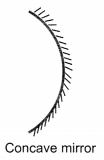
(ii) convex mirror
Question 2.
Define focal length.
Answer:
Focal length (f): The distance between the pole and principal focus (F) of a spherical mirror is called the focal length of the mirror. It is denoted by f.
f = 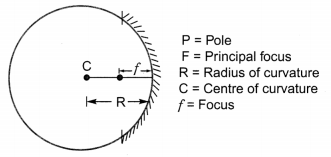
Question 3.
Define one dioptre.
Answer:
1 dioptre is the power of a lens whose focal length is 1 metre. 1 D = 1 m-1
Question 4.
Define focus.
Answer:
Principal focus: A point on the principal axis of a spherical mirror where the rays of light parallel to the principal axis meet or appear to meet after reflection from the spherical mirror is called principal focus.
Question 5.
What is concave and convex mirror?
Answer:
- Concave mirror: A spherical mirror, whose reflecting surface is curved inwards, that is it faces towards the centre of the sphere, is called a concave mirror.
- Convex mirror: A spherical mirror whose reflecting surface is curved outwards, is called a convex mirror.
Question 6.
Define
1. Reflection of light
2. Beam of light
Answer:
(1) Reflection: When light falls on a surface and bounces back to the medium, the phenomena is called reflection.
(2) Beam: A beam is a bundle of rays, which originates from a common source and travels in the same direction.
Question 7.
Define light and write its properties.
Answer:
Light: It is a form of energy which produces the sensation of sight.
- Light exhibits dual nature i.e., wave as well as particle nature.
- It travels with speed of 3 × 108 m/s in vacuum. However, speed is inversely proportional to optical density of medium.
Question 8.
Draw a ray diagram showing the path of rays of light when it enters with oblique incidence (i) from air into water.
Answer: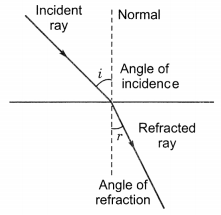
Short Answer Type I
Question 1.
Draw the ray diagrams showing the image formation by a concave lens.
Answer:
| Position of the object | Position of the image | Relative size of the image | Nature of the image |
| At infinity | At focus F1 | Highly diminished point sized | Virtual and erect |
| Between infinity and optical centre O of the lens | Between focus F and optical centre O | Diminished | Virtual and erect |
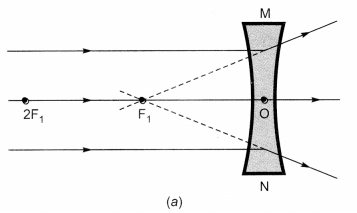
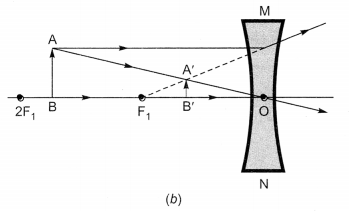
Nature, position and relative size of the image formed by a concave lens
Question 2.
Write lens formula and define magnification.
Answer:
Lens formula and magnification
u = object distance
v = image distance
f = focal length
Magnification (m): Magnification is defined as the ratio of height of image and to height of the object.
h’ = height of image
h = height of object
Question 3.
State laws of reflection.
Answer:
Laws:
- The angle of incidence is equal to the angle of reflection.
- The incident ray, the normal to the mirror at the point of incidence and reflected ray, all lie in the same plane.
These laws of reflection are applicable to all types of reflecting surfaces including spherical surfaces.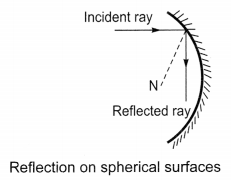
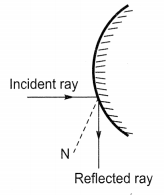
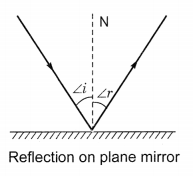
Question 4.
Write four difference between real and virtual image.
Answer:
Real image:
- When rays of light after reflection meets at a point real image is formed.
- Real image can be obtained on screen.
- Real image is formed in front of mirror.
- Real image is always inverted.
Virtual image:
- When rays of light do not actually meet but appear to meet at a point after reflection, virtual image is formed.
- Virtual image cannot be obtained on screen.
- Virtual image is formed behind the mirror.
- Virtual image is always erect.
Question 5.
If the speed of light in vacuum is 3 × 108 ms-1, find the speed of light in a medium of absolute refractive index 1.5.
Answer:
Here, v1 = 3 × 108 m/s, n1 = 1, n2 = 1.5
v2 =
v2 = 2 × 108 m/s
Question 6.
An object of height 6 cm is placed perpendicular to the principal axis of a concave lens of focal length 5 cm. Use lens formula to determine the position, size and nature of the image if the distance of the object from the lens is 10 cm.
Answer:
h = 6 cm, f = -5 cm, u = -10 cm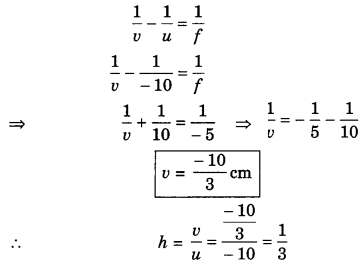
Image is diminished and erect.
Question 7.
Define refractive index and relative refractive index.
Answer:
1. Refractive index: The ratio of speed of light in vacuum (c) to the speed of light in any medium (v) is called refractive index of the medium.![]()
2. Relative refractive index: The relative refractive index of a medium with respect to other medium is the ratio of the speed of light in the first medium with respect to the second medium.![]()
Here, n21 = Relative refractive index of medium 2 with respect to medium 1 is
Here, n12 = Relative refractive index of medium 1 with respect to medium 2.
Question 8.
Write some illustrations of refraction.
Answer:
Some applications of refraction:
- Bottom of a tank or a pond containing water appears to be raised due to refraction.
- When a thick glass slab is placed over some printed matter the letters appear raised when viewed through the glass slab.
- When a pencil is partly immersed in water, it appears to be bent at the interface of air and water.
- A lemon kept in water in a glass tumbler appears to be bigger than its actual size, when viewed from the sides.
Question 9.
Name the type of mirror used in solar furnace. How is high temperature achieved by this device? (CBSE 2012)
Answer:
Concave mirror is used in solar furnace. The solar furnace is placed at the focus of the large concave reflector. The concave reflector focus the Sim’s heat rays on the furnace and a high temperature is achieved.
Question 10.
The absolute refractive indices of glass and water are
Answer:
Given, µg=
Speed of light in glass = 2 × 108 ms-1
(i) Speed of light in vacuum, c = µg × vg =
(ii) Speed of light in water,
Question 11.
A convex lens of focal length 25 cm and a concave lens of focal length 10 cm are placed in closed contact with each other. Calculate the lens power of the combination.
Answer:
Power of convex lens, P1 =
Power of concave lens, P2 =
power of combination, P = P1 +P2 = 4D – 10D = -6D
Short Answer Type II
Question 1.
Define power of a lens. What is its unit? One student uses a lens of focal length 50 cm and another of -50 cm. What is the nature of the lens and its power used by each of them? (NCERT Exemplar)
Answer:
Power of a lens: The power of a lens is defined as reciprocal of its focal length.
P =
f= focal length (in metre)
The SI unit of power is ‘dioptre’. It is denoted by the letter D.
Here, f= 50 cm = 0.5 m
Power P =
f = – 50 cm = -0.5 m
Power P =
Question 2.
Define lens. What is difference between convex and concave lens?
Answer:
Lens: A transparent medium bound by two surfaces, of which one or both surfaces are spherical, forms a lens:
Convex lens: A lens having two spherical surfaces, bulging outwards is called a double convex lens or convex lens.
- It is thicker at the middle as compared to the edges.
- Convex lens converges light.
Hence, convex lens are called converging lens.
Concave lens: A double concave lens is bounded by two spherical surfaces curved inwards.
- It is thicker at edges than in the middle.
- Concave lens is diverging in nature.
Question 3.
Draw ray diagrams showing the image formation by a convex mirror when an object is placed (NCERT Exemplar)
(a) at infinity
(b) at finite distance from the mirror
Answer:
Formation of image by convex mirror:
| Position of the object | Position of the image | Relative size of the image | Nature of the image |
| At infinity | At focus F behind the mirror | Highly diminished, point sized | Virtual and erect |
| Between infinity and the pole P of the mirror | Between P and F behind the mirror | Diminished | Virtual and erect |
Ray diagram for image formation by convex mirror: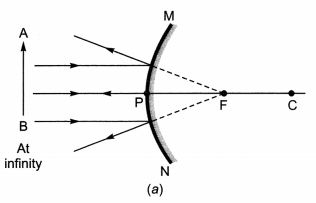
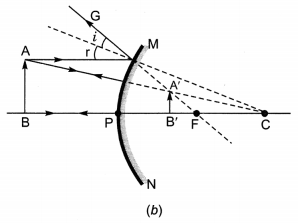
Question 4.
Write down the uses of concave and convex mirror.
Answer:
Uses of mirrors:
1. Uses of concave mirrors:
- Concave mirrors are commonly used in torches, searchlights and vechicles headlights to get powerful beam of light.
- It is used in shaving mirrors to see large image of the face.
- Dentists use concave mirror to see large images of the teeth of patients.
- Large concave mirrors are used to concentrate sunlight to produce heat in solar furnace.
2. Uses of convex mirrors
- Convex mirrors are used as rear-view (wing) mirrors in vehicles.
- Convex mirrors are used as street reflectors because they are able to spread light over a bigger area.
Question 5.
(i) “The refractive index of kerosene is 1.44.” What is meant by this statement?
(ii) A ray of light strikes a glass slab of an angle of incidence equal to 30°. Find the refractive index of glass such that the angle of refraction is 19.5°. (Take sin 19.5° =
Answer:
(i) Refractive index of any medium with respect to another indicated the extent to which binding of light takes place when it enters from the first medium to the given medium. The given value of refractive index also states that speed of light in kerosene is
(ii) Given, i = 30°, r = 19.5°
Long Answer Type
Question 1.
Write the laws of refraction. Explain the same with the help of ray diagram, when a ray of light passes through a rectangular glass slab. (NCERT Exemplar)
Answer:
Laws of refraction:
- The incident ray, the refracted ray and the normal at the point of incidence, all lie in the same plane.
- The ratio of sine of angle of incidence to the sine of angle of refraction is a constant, for the light of a given colour and for the given pair of media. This law is also known as Snell’s law of refraction.
If i is the angle of incidence and r is angle of refraction.
sin i / sin r = constant
Refraction through glass slab:
- The ray of light enters from rarer to denser medium at point O that is from air to glass and bends towards the normal.
- At ‘O’, the light ray enters from glass to air, that is, from a denser medium to a rarer medium. The light here bends away from normal.
- The emergent ray is parallel to the incident ray. However the light ray shifts slightly sideward.
- Refraction is due to change in speed of light when it enters from one medium to another.
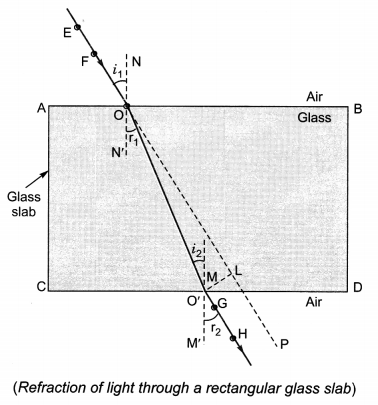
Question 2.
Draw ray diagrams showing the image formation by a convex lens when an object is placed (NCERT Exemplar)
(a) between optical centre and focus of the lens
(b) between focus and twice the focal length of the lens
(c) at twice the focal length of the lens
(d) at infinity
(e) at the focus of the lens
Answer:
Nature, position and relative size of the image formed by a convex lens for various positions of the object
| Position of the object | Position of the image | Relative size of the image | Nature of the image |
| (a) Between optical centre O and focus F1 | On the same side of the lens as the object | Enlarged | Virtual and erect |
| (b) Between F1 and 2F1 | Beyond 2F2 | Enlarged | Real and inverted |
| (c) At 2F1 | At 2F2 | Same size | Real and inverted |
| (d) At infinity | At focus F2 | Highly diminished, point-sized | Real and inverted |
| (e) At focus F1 | At infinity | Infinitely large or highly enlarged | Real and inverted |
Ray diagram for the image formation by convex lens:

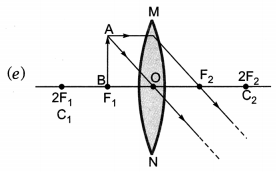
The position, size and the nature of the image formed by a convex lens for various positions of the object.
Question 3.
Draw ray diagrams showing the image formation by a concave mirror when an object is placed
(a) at the focus of the lens
(b) between focus and twice the focal length of the lens
(c) beyond twice the focal length of the lens
Answer:
Image formation by a concave mirror for different positions of the object
| Position of the object | Position of the image | Size of the image | Nature of the image |
| (a) At F | At infinity | Highly enlarged | Real and inverted |
| (b) Between C and F | Beyond C | Enlarged | Real and inverted |
| (c) Beyond C | Between F and C | Diminished | Real and inverted |
Question 4.
Draw ray diagram for the image formation by a concave mirror.
Answer: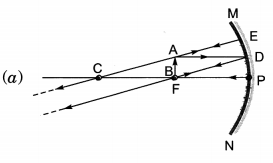
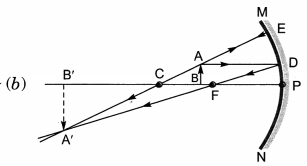
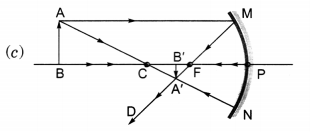
Question 5.
A spherical mirror produces an image of magnification -1 on a screen placed at a distance of 50 cm from the mirror.
(a) Write the type of mirror.
(b) Find the distance of the image from the object.
(c) What is the focal length of the mirror? (CBSE 2014)
Answer:
(a) Concave mirror
(b) m = -1, u = -50 cm,
∴ v = -50 cm
(c)
∴ f = -25 cm
Question 6.
Draw a ray diagram to show the path of the reflected ray in each of the following cases. A ray of light incident on a convex mirror and concave mirror
(a) strikes at its pole making an angle θ with the principal axis.
(b) is directed towards its principal focus.
(c) is parallel to its principal axis.
Answer:
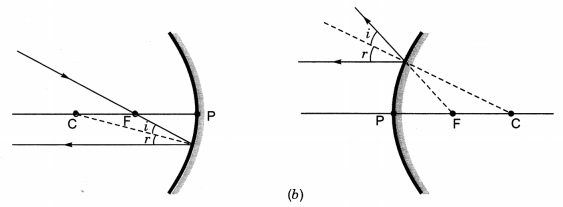
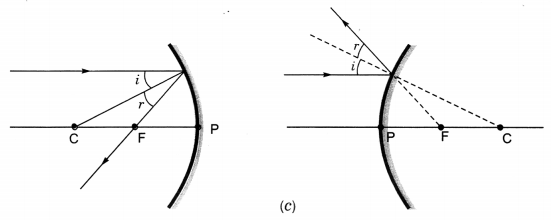
HOTS Questions With Answers
Question 1.
The refractive indices of water and glass with respect to air are 4/3 and 3/2 respectively. If the speed of light in glass is 2 × 108 ms-1, find the speed of light in (i) air, (ii) water.
Answer:
(i) Let v1 = speed of light in air,
v2 = speed of light in glass,
then,
v1 =
(ii) Let = speed of light in water,
v2 = speed of light in air,
then
=
v1 =
Question 2.
The image of a candle flame formed by a lens is obtained on a screen placed on the other side of the lens. If the image is three times the size of the flame and the distance between lens and image is 80 cm, at what distance should the candle be placed from the lens? What is the nature of the image at a distance of 80 cm and the lens? (NCERT Exemplar)
Answer:
m = ![]()
Image is real (obtained on screen), inverted and enlarged. The lens is convex.
Question 3.
Size of image of an object by a mirror having a focal length of 20 cm is observed to be reduced to 1/3rd of its size. At what distance the object has been placed from the mirror? What is the nature of the image and the mirror?
Answer:
Therefore the mirror is convex and the image is virtual, erect, and diminished.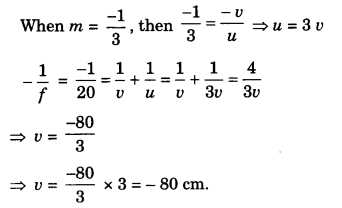
Therefore, the mirror is concave and the image is real, inverted and diminished.
Question 4.
A student focussed the image of a candle flame on a white screen using a convex lens. He noted down the position of the candle screen and the lens as under (NCERT Exemplar)
Answer:
Position of candle = 12.0 cm
Position of convex lens = 50.0 cm
Position of the screen = 88.0 cm
(i) What is the focal length of the convex lens?
(ii) Where will the image be formed if he shifts the candle towards the lens at a position of 31.0 cm?
(iii) What will be the nature of the image formed if he further shifts the candle towards the lens?
(iv) Draw a ray diagram to show the formation of the image in case (iii) as said above.
Answer:
(i) Here, u = – 38 cm, v = 38 cm![]()
(ii) u = – 19 cm
V = ∞
(iii) The object (candle) will be between the principal focus and optical centre. Hence image formed will be enlarged, virtual and erect.
(iv)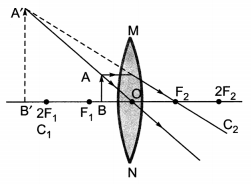
Question 5.
Identify the device used as a spherical mirror or lens in the following cases, when the image formed is virtual and erect in each case.
(a) Object is placed between device and its focus, image formed is enlarged and behind it.
(b) Object is placed between the focus and device, image formed is enlarged and on the same side as that of the object.
(c) Object is placed between infinity and device, image formed is diminished and between focus and optical centre on the same side as that of the object.
(d) Object is placed between infinity and device, image formed is diminished and between pole and focus, behind it.
Answer:
(a) Concave mirror
(b) Convex lens
(c) Concave lens
(d) Convex mirror
Question 6.
Sudha finds out that the sharp image of the window pane of her science laboratory is formed at a distance of 15 cm from the lens. She now tries to focus the building visible to her outside the window instead of the window pane without disturbing the lens. In which direction will she move the screen to obtain a sharp image of the building? What is the approximate focal length of this lens? (NCERT Exemplar)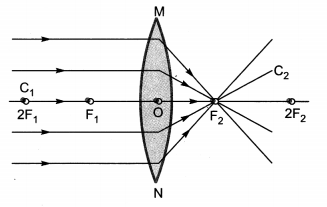
Answer:
Sudha should move the screen towards the lens so as to obtain a clear image of the building. Here the object is at infinity and hence a sharp image of the object is formed at the principal focus (F1) of the lens. Hence, the approximate focal length of this lens will be 15 cm.
Value Based Questions
Question 1.
Amit and Sumeet visited National Bal Bhawan on Environmental day. There they saw a concentrator type of solar cooker installed for Basic heating usage. Give the answers of the following questions:
(i) Type of mirror used in concentrating type solar cooker
(ii) Values shown by the organisation
Answer:
(i) Concave mirror
(ii) Organisation management is good and have a knowledge of conservation of energy
Question 2.
Ravi went to Manali during summer vacation. He saw a type of mirror was installed by road management to avoid accident.
Give the answers of following questions:
(i) Type of mirror used.
(ii) Values shown by road management
Answer:
(i) Convex mirror
(ii) Road management had displayed the correct use of knowledge as a convex mirror gives erect image and a wider field of view. The management had taken concern to avoid accidents.
Comments
Post a Comment